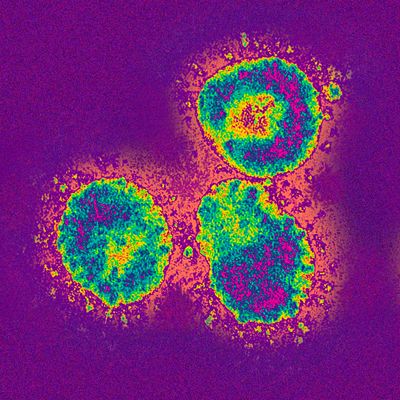
As researchers try to understand why some people infected with COVID-19 experience mild or nonexistent symptoms while others require hospitalization, one factor they have considered is the “viral load” — the amount of the virus detected in a patient. “The viral load is a measure of how bright the fire is burning in an individual,” Edward Parker of the London School of Hygiene and Tropical Medicine, told New Scientist. Early indications suggest a correlation between the fire and the burn in COVID-19 patients: People with larger viral loads are generally getting sicker.
To get a sense of the scientific basics around this question, Intelligencer spoke with Dr. Ellen Foxman, assistant professor of laboratory medicine and immunobiology at Yale School of Medicine, about the way viruses work, coronavirus testing accuracy, and how COVID-19 could be like other illnesses.
What do we know about the relationship between viral load and the severity of a COVID-19 case?
According to recent papers that came out in the past week or so, at least in two papers from The Lancet, which is a quite reputable medical journal, there is a correlation between high viral load and more severe symptoms. That really makes a lot of sense, because viral replication is needed for a virus to cause diseases. Usually, only a few viruses get in your body, but then they begin to make copies of themselves. That process of taking over cells and replicating is what leads to disease. If the viruses can’t replicate much, in general they don’t cause as much disease.
In these papers, they did longitudinal studies. They followed people over the course of time. As you can imagine, if the viral load goes up and then it goes back down, the test result depends on when you are measuring. We can’t say, “This person walked into the doctor and had this viral load and that means they’re going to have severe disease.” Because the meaning of the viral load also depends on when in the disease process you’re testing.
There are also a few studies out of China and Italy that seem to indicate viral load is not a factor in severity. What do you make of them?
Those studies are “preprints,” meaning that they have not yet undergone scientific peer review and are not officially published. For the paper from Italy, I don’t think the authors are making a case for lack of correlation of viral load with symptoms — they simply show a great degree of variability in viral load for both symptomatic and asymptomatic patients, so it’s difficult to conclude anything either way.
The Lancet articles have undergone peer review. This is the gold standard for reliability in scientific papers. People should know the difference — sometimes preprints change a great deal in response to comments and critiques from peer reviewers before they are accepted for publication.
Did The Lancet studies distinguish between a viral load that is a measure of the virus’s replication in a patient and the infectious dose, i.e. the patient’s exposure?
Yes, that’s an important distinction. Viral load described in the recent papers is the amount of virus measured in a sick person’s nose and throat. Someone is sick, they come to their doctor, they get a swab of their nose and throat, and the test measures how much virus is there. Based on The Lancet studies, measuring more virus over the course of infection correlates with more symptoms and more severe disease.
As far as transmitting from person to person, it makes sense that the amount of virus you are exposed to impacts how likely you are to become infected. If there’s one virus on a doorknob, you’re much less likely to get sick from touching the doorknob than if there’s 1,000 viruses on that doorknob. With a bigger exposure, some of the viruses are more likely to actually get into your airway and find a place to replicate. If you’re exposed to no virus at all, you’re not going to get sick. If you’re exposed to one little viral particle, you probably have a much lower chance of becoming infected than if you are right next to someone on an airplane who is coughing for eight hours. The amount of virus needed to cause an infection is the infectious dose, which is different than the viral load.
How will studying the viral load in greater depth change how we manage this virus?
I think it’s very helpful. First of all, the way most people are tested right now is by putting a swab in the nasopharynx, which is the nose and the back upper part of the throat, and then looking for the viral genetic material. That’s the gold-standard test. But what’s really interesting is that the test isn’t necessarily positive or strong positive throughout the whole disease. That’s really important to know. Just because somebody is negative on that test, doesn’t mean they don’t have the disease. We’re making a lot of decisions on how to care for people, whether they should self-isolate, all of these things based on that test. It’s very important to figure out not only the viral load, but even how well these tests work to categorize someone as having the disease.
Studies showing that viral load correlates with severity of disease make sense in terms of what we know about other viruses. My laboratory studies respiratory viruses and it makes me think that a lot of the rules about other respiratory viruses may also apply to this one. It really helps in thinking about how to approach it from a research standpoint. What it says to me is, if the virus can be controlled and cleared when it’s still in the nose and throat, you are going to have a more mild case. I wouldn’t say it’s 100 percent, but what it says to me is that this virus infects the nose and throat, and if the local mechanisms to get rid of the virus are really effective and don’t let the viral load get too high, then that person is on the pathway to a more mild disease. Whereas if this virus is able to grow a whole bunch and really replicate to a high level in the nose and throat, you have a much higher chance of inhaling it into your lungs where the virus could set up shop.
But if we do detect it when it’s in the nose and throat, what can we do about it at this point?
Nothing right now. But I hope there will be something we can do eventually. My lab is investigating that. My laboratory works on natural defense mechanisms — innate immune mechanisms — in the upper respiratory tract that can quash viruses before they cause illness. Of course, there is no magic pill right now, but at least this makes sense and suggests some immediate directions to investigate.
*This interview has been lightly edited and condensed for clarity.






























